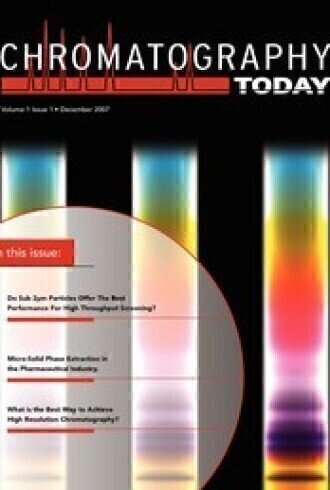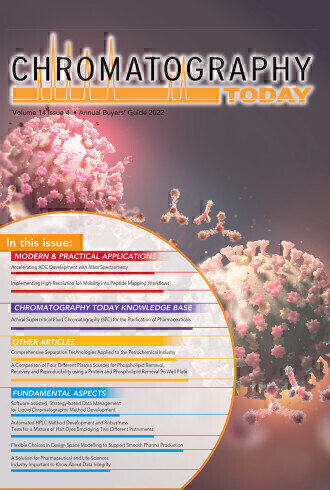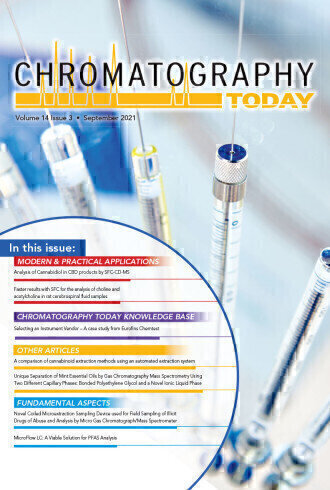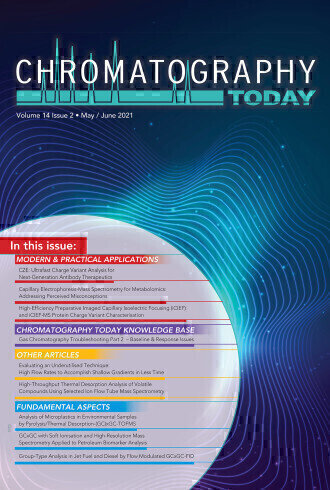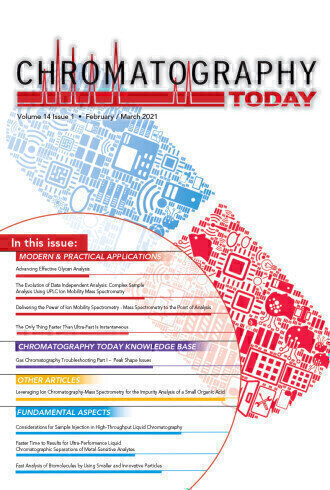Volume 1 Issue 1
As President of the Chromatographic Society, it gives me great pleasure to introduce the first edition of the new Chromatography Today publication. There is a need for a publication of this nature and it will provide a platform to reflect the current state of the art and future trends in chromatographic and electrophoretic techniques.
The area of analytical science is currently in a rich vein with new advances occurring on a seemingly weekly basis. Certainly it is arguable that this branch of science has the greatest impact on and consequence for a
whole range of other disciplines. Analytical chemistry touches on food, forensic, agrochemical and pharmaceutical areas to name but a few, and is becoming increasingly important in helping governments in counter-terrorism efforts. There are many areas worthy of discussion in the inaugural edition of Chromatography Today, but the area which is likely to be of most interest (and some controversy) to the majority of liquid chromatographers is the emergence of Ultra High Pressure Liquid Chromatography (UHPLC) [1-7] and its alternatives. A number of vendors have brought instruments to the market capable of providing pressures up to 1000 bar. This allows the use of sub 2 micron particles which in turn can provide higher chromatographic efficiencies and faster analysis times. This area was a key focus for the Chromatographic Society ‘Triad’ series of
meetings which were held in 2006 at three large UK Pharma sites (AZ Charnwood (Loughborough), Pfizer (Sandwich) and GSK (Stevenage) with its utility and application being primarily highlighted by speakers from
the pharmaceutical industry. However, other approaches to increasing chromatographic speed and efficiency have been highlighted by a number of stationary phase manufacturers as alternatives to UHPLC technology. Most recently, the use of sub 3 micron pellicular-like materials has been demonstrated [7-11]. It is claimed that these phases can provide similar efficiencies to sub 2-micron particles but with approximately half to two thirds of the back-pressure allowing UHPLC like chromatography on conventional HPLC instrumentation. ‘Conventional’ silica manufacturers have also been keen to highlight and contrast the utility of ‘standard’
particles in the 2.5 to 3 micron range. Again, they claim that similar (or even better) chromatographic efficiencies may be realised with these particles when compared to sub 2-micron technology. In this volume of
Chromatography Today, this latter approach is discussed by two column vendors. While we endorse this discussion, the articles do not necessarily reflect the views of the editorial board. In future editions, other
authors will provide alternative views as a riposte to these arguments.
In future editions we will touch on other important areas of separation science. These will include UPLC, advances in GC, SFC, chiral and preparative chromatography along with emerging trends such as high temperature and chip technologies. As such we will be drawing upon our wide network of separation scientists, often those featuring in our meetings, to bring you the best informed authors possible. There will also be news from the Chromatographic Society, including previews of forthcoming events. We hope this publication will help meet the needs of the practicing chromatographer and the separation science community in general.
I hope you enjoy Chromatography Today and we look forward to providing you with informative, relevant and useful articles to aid your chromatographic practices.
Previous Digital Editions
Digital Edition
Chromatography Today - Buyers' Guide 2022
October 2023
In This Edition Modern & Practical Applications - Accelerating ADC Development with Mass Spectrometry - Implementing High-Resolution Ion Mobility into Peptide Mapping Workflows Chromatogr...
View all digital editions
Events
Apr 23 2024 Kintex, South Korea
Apr 23 2024 Seoul, South Korea
Apr 28 2024 Montreal, Quebec, Canada
May 05 2024 Seville, Spain
May 15 2024 Birmingham, UK
